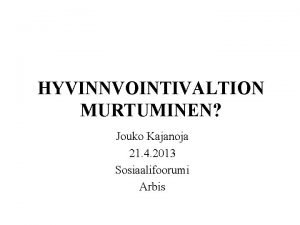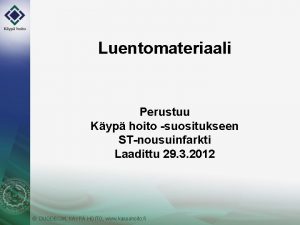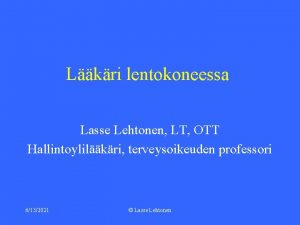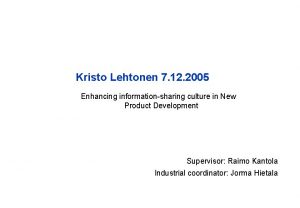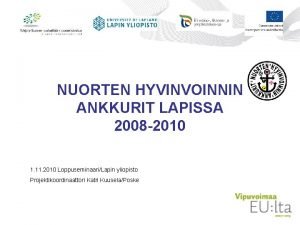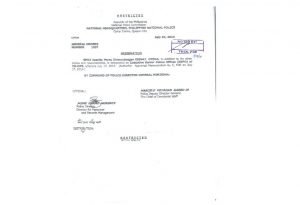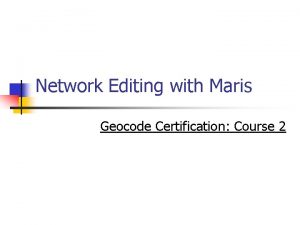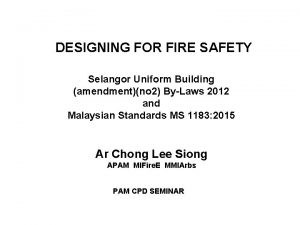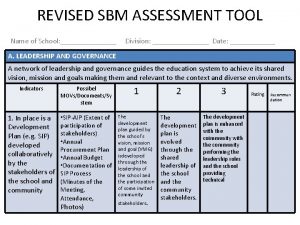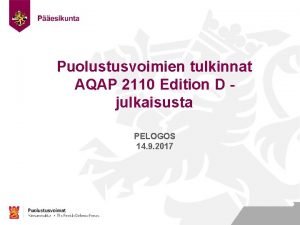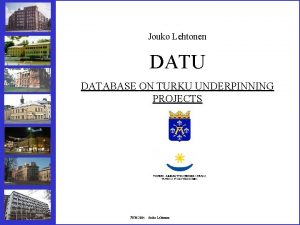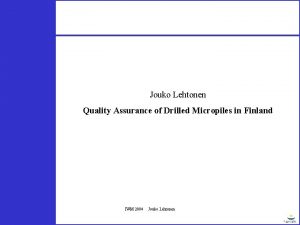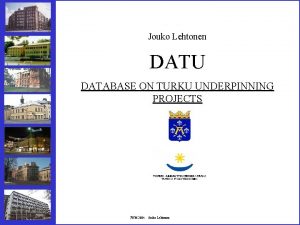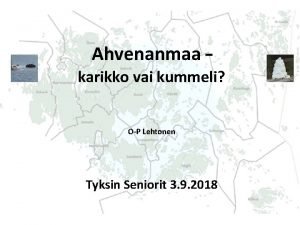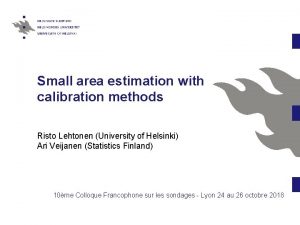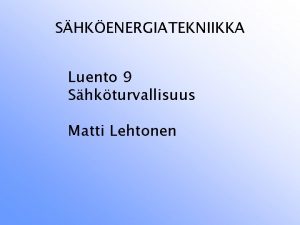Jouko Lehtonen The PYRAMIT project and the latest




























- Slides: 28

Jouko Lehtonen The PYRAMIT project and the latest laboratory tests of micropiles at TUT IWM 2004 Jouko Lehtonen

The PYRAMIT project Dr Mauri Koskinen, HUT Dr Jukka Rantala, TUT Objectives: to develop micropile foundations to vertically large (high) and slender structures Contents: field tests of Titan and RD piles; collection of micropile foundation structures The latest laboratory tests of micropiles at TUT Mirko Harjula, MSc thesis Objectives: to verify shaft resistance of micropiles in loose soil material Contents: laboratory tests of RD / RR CSG piles IWM 2004 Jouko Lehtonen

PYRAMIT RD 88. 9 x 6. 3 mm, drill bit D = 150 mm. IWM 2004 Jouko Lehtonen

Titan 40/16 mm, drill bit D = 90 mm. IWM 2004 Jouko Lehtonen

Dynamic probing and weight sounding tests, nr 1 on left and nr 2 on right. IWM 2004 Jouko Lehtonen

Excavated and uplifted micropiles, T 4 (on left) ja RD 1 (on right). IWM 2004 Jouko Lehtonen

Soil and Cement Mix Filtered cement Neat cement Pile structure T 4 (on right) and RD 1 (on left). IWM 2004 Jouko Lehtonen

Structure of a RD micropile IWM 2004 Jouko Lehtonen

IWM 2004 Jouko Lehtonen

Windmill tower foundation IWM 2004 Jouko Lehtonen

Windmill tower foundation IWM 2004 Jouko Lehtonen

Telemasts etc IWM 2004 Jouko Lehtonen

Telemasts etc IWM 2004 Jouko Lehtonen

Noise barriers etc IWM 2004 Jouko Lehtonen

Noise barriers etc IWM 2004 Jouko Lehtonen

RD – and RR – CSG – micropiles Latest experiments in loose and medium dense sand, tests at TUT Mirko Harjula, Tampere University of Technology TUT, Laboratory of foundation and earth structures, Development of planning and installation of RD – CSG – piles, research assistant IWM 2004 Jouko Lehtonen

PART 1: CSG – micropiles and geotechnical capacity • RR- / RD – CSG - piles – Steelgrade up to 550 J 2 H – Diameter 60… 300 mm, normally 90… 140 mm – Installation methods: driving, jacking, drilling or screwing • CSG = Continuously Shaft Grouted – Pile grouted inside-out simultaneously to pile installation – Grout through holes inside collar or drill bit flushing holes – Grout body thickness minimum 20 mm outside pile – W/C ~0. 4 – 0. 6 with portland cement IWM 2004 Jouko Lehtonen

Geotecnical capacity of the CSG – piles • • Ru Rbu Rsu CSG – pile transfers loads from superstructure to soil mainly through it’s shaft Geotechnical capacity depends on friction forces between pile grout body and surrounding soil Geotechical capacity can be calculated when pile´s collar, drill bit or effective diameter and surrounding soil conditions are known Normal way to calculate CSG – pile capacity on it’s limit state condition is: = pile capacity at the limit state = pile base limit state capacity = pile shaft limit state capacity CSG – piles shaft and base resistance can be calculated throught experimentaly made tables or using soil parameters and known pile base and shaft areas IWM 2004 Jouko Lehtonen

Base resistance (Rbu) • Rbu = qbu + Ab • Ab = area of pile base • qbu can be calculated using pile and • soil parameters or readymade tables Soil parameters: – qbu = σ’v * Nq – σ’v = vertical stress meanvalue at the pile lenght – Nq = bearing capacity multiplier, corresponding to pilesoil friction angle (top right) • Readymade tables (table right down) IWM 2004 Jouko Lehtonen

Shaft Resistance (Rsu) • Rsu = qsu * As = Ks * tanφa * σ’v * As = β * σ’v * As • • • qsu = pile shaft resistance / square meter As = effective shaft area Ks = lateral earth pressure φa = pile – soil friction angle after pile installation σ’v = effective vertical stress at the pile lenght • Soil parameters – Shaft resistance can be calculated as shown above. Values for β calculation can be taken from topmost picture. Values shown at the picture are experimental values which has been made through many field studies. • Readymade tables (right down) – Table as shown is based on experimental field tests and is in daily use, when planning CSG- piling sites. IWM 2004 Jouko Lehtonen

Part 2: Latest experiments • Until now CSG – piles has been tested and manufactured mainly for sites where pile has been driven or drilled from dense to very dense layer. • Piles has not been validly tested in loose and medium dense soils such as loose sand silt until recently. • Next pages are part of latest results from Tampere University of Technology, Laboratory of foundation and earth structures´ project ”Developement of installation and planning of RD – CSG – piles”. IWM 2004 Jouko Lehtonen

RD – CSG - project • Project is a main part of a master thesis that is carried out by literature surveillance, laboratory and field tests • Main goals are to study and develop drilled CSG – piles in soft soil. Such as loose silt and sand. • Develop codes of planning and installation for CSG – piles. Update old CSG – codes (Rautaruukki Oyj, 2002) • Study how skinfriction improves geotechnical capasitance. • Study how much grout surface can protect steel-pipe-pile against corrosion and estimate how much cement is needed to make a single CSG - pile and group of piles costs and economy IWM 2004 Jouko Lehtonen

Test environment • Test site was Tampere University of Technology’s, Laboratory of foundation and earth structures test pit • Test pit dimensions were 2. 5 x 5. 0 m • Test pit was filled with medium sized sand that was filled and compacted at 0. 2… 0. 3 m layers. • Compaction was made with 100 kg hydraulic compactor IWM 2004 Jouko Lehtonen

Tested soil material • Soil material at the test pit was medium sized sand • Moisture ratio 4%, optimum ratio from Proctor test was 15% • σ = 16. 8 k. N/m 3 • Dynamic probing resistance N 20 mainly under 20 ht/0. 2 m. • Sand frictionangle φ = 33° before piling, after piling ~36 ° IWM 2004 Jouko Lehtonen

Tested piles • Totally 10 piles has been installed at 2 installation procedures by now. • First five RR - CSG - piles were installed with BSP 500 (top right) hydraulic driven machine. Next five RD – CSG - piles were installed with KLEM 802 (below right) drilling rig using top-hammer drill. • Piling length for all piles has been 4 m. • CSG – piles were grouted for whole length. • Tested piles: – 2 x RR 90 CSG 140 – 2 x RR 90 plain steel – 2 x RR 140 plain steel – 4 x RD 90 CSG 140 • At least 4 piles is still coming in for testing. IWM 2004 Jouko Lehtonen

Pile testing • All piles were tested in compression, until either structural or geotechnical capacity reached it’s limit. • Piles were tested with hydraylic jack, force gauge and four gauges which measured pile head settlement during loading. • Testing procedure was: – Calculating pile geotechnical capacity – Calculating eight loading steps for pile before calculated geotechnical limit state – Loading pile with calculated loading steps, every step was maintaned until pile settlement was below 0. 004 mm/min…at least 10 minutes. – Loading steps were made until pile reached it’s limit state – Limit load was maintained 5 - 10 minutes – Unloading from limit load was made with five steps and every step was maintained 5 minutes IWM 2004 Jouko Lehtonen

Test results • Pile tests has now been performed for ten piles. For six CSG – piles and four plain steel piles. • It has come quite clear that CSG – piles´ geotechnical capacity and loading curve differs greatly from those of plain steel • For all CSG – piles which were tested in sand geotechnical capacity has been over 200 k. N. At the same conditions, plain steel piles have reached loading level about 70 - 100 k. N. • CSG – pile skin friction at loose sand has been over 100 k. Pa/m 2. • β value after negating base recistance from total pile load has been calculated to be about 2. 9. In calculations frictionangle, after CSG – pile installation, between pile and soil is 36° and σ = 16. 8 k. N/m 3 for whole pile lenght (4 m). IWM 2004 Jouko Lehtonen

Afterwords • RD – CSG – project is still going on and new data is coming in every day • At the future we hope to make better piles more efficiently, cheaper and economically than today • Still there is much to study and work so let’s make it together – Mirko Harjula, Tampere University of Technology, Laboratory of foundation and earth structures, Development of planning and installation of RD – CSG – piles, recearch assistant IWM 2004 Jouko Lehtonen
 Jouko lehtonen
Jouko lehtonen Osallistumistulo
Osallistumistulo Jouko kajanoja
Jouko kajanoja Jouko kinnunen
Jouko kinnunen Yrityksen ydinosaaminen
Yrityksen ydinosaaminen Merituuli lehtonen
Merituuli lehtonen Hannu lehtonen professori
Hannu lehtonen professori Kaupallinen neuvonanto
Kaupallinen neuvonanto Hannu lehtonen professori
Hannu lehtonen professori Rainer lehtonen
Rainer lehtonen Olli lehtonen luke
Olli lehtonen luke Antitrombootit
Antitrombootit Time series for dummies
Time series for dummies Pyry lehtonen
Pyry lehtonen Terveysoikeus
Terveysoikeus Kristo lehtonen
Kristo lehtonen Anurag lehtonen
Anurag lehtonen Latest electronics and information technology in odisha
Latest electronics and information technology in odisha Florence and the machine lyrics
Florence and the machine lyrics Where does maria park her car
Where does maria park her car Prayer points for philippines
Prayer points for philippines Pnp organizational structure 2021 with names
Pnp organizational structure 2021 with names Latest updates from upstu
Latest updates from upstu Fire appliance access
Fire appliance access Is 10262 code 2019
Is 10262 code 2019 Accountability and continuous improvement on smepa
Accountability and continuous improvement on smepa Aqap 2110 latest edition
Aqap 2110 latest edition Oracle apex 19 new features
Oracle apex 19 new features Occupancy load factor
Occupancy load factor


